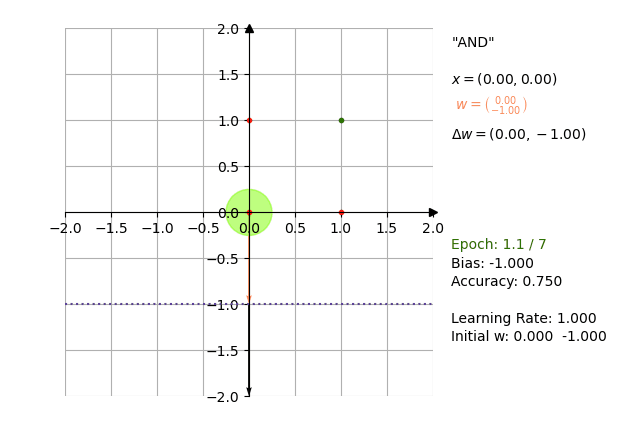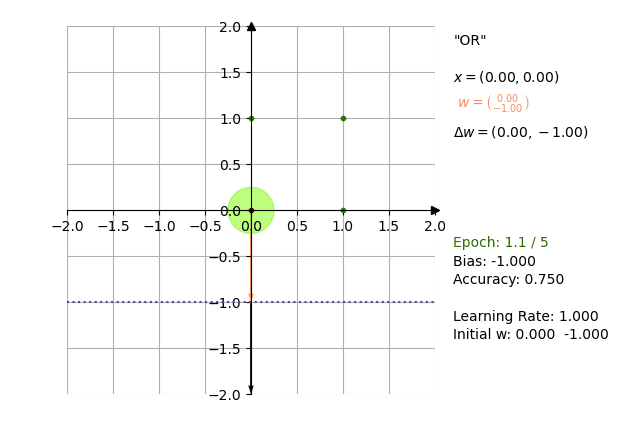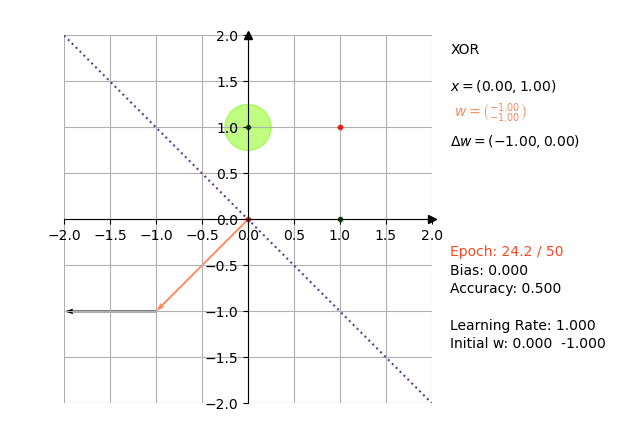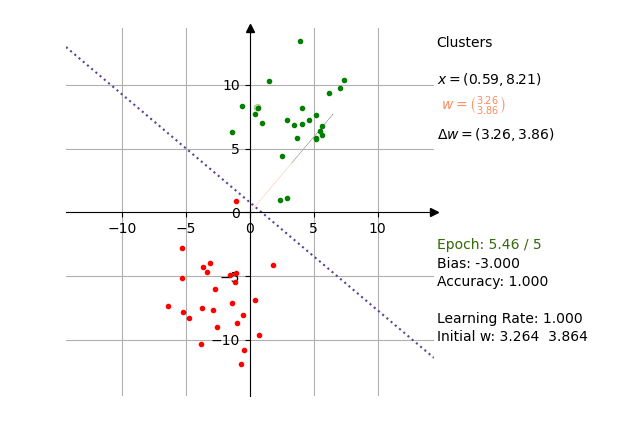Perceptron Function Plotting with Python
I have updated my Perceptron-implementation with a plotting function that allows for visualizing the adjustments of the Perceptron's weight-vector through the epochs.
The source-code can be found at https://github.com/ThorstenSuckow/pylabs.
Usage
Create input data and the associated output values. As an example, the following represents the logical AND-function:
import numpy as np
from Perceptron import Perceptron
# input
X = np.array([
[0, 0], [0, 1], [1, 0], [1, 1]
])
# output
y = np.array([0, 0, 0, 1])
In the next step, the Perceptron is created.
p = Perceptron(50, 0.3)
Once a Perceptron-instance is available, you can pass the input- and output-values to learn():
p.learn(X, y)
and test data with
result = p.test([0, 0])
result holds the computed weight vector if the training data could be separated within the epochs. If that failed,
None is returned.
Note: The bias is available with p.bias
A log is available for all steps processed by learn():
for step in p.log:
print(step)
You can pass the log to the PerceptronPlotter which will recreate the computation visually.
Examples
and
The and-function with a Perceptron.
| 1 | 1 | 1 |
| 1 | 0 | 0 |
| 0 | 1 | 0 |
| 0 | 0 | 0 |
X = np.array([
[0, 0], [0, 1], [1, 0], [1, 1]
])
title= "\"AND\""
y = np.array([0, 0, 0, 1])
p = Perceptron(50)
p.learn(X, y)
plotter = PerceptronPlotter(p.log, X, y, title)
anim = plotter.animate(500)

or
The or-function with a Perceptron.
| 1 | 1 | 1 |
| 1 | 0 | 1 |
| 0 | 1 | 1 |
| 0 | 0 | 0 |
X = np.array([
[0, 0], [0, 1], [1, 0], [1, 1]
])
title= "\"OR\""
y = np.array([0, 1, 1, 1])
p = Perceptron(50)
p.learn(X, y)
plotter = PerceptronPlotter(p.log, X, y, title)
anim = plotter.animate(500)

xor
The xor-function with a Perceptron.
| 1 | 1 | 0 |
| 1 | 0 | 1 |
| 0 | 1 | 1 |
| 0 | 0 | 0 |
X = np.array([
[0, 0], [0, 1], [1, 0], [1, 1]
])
title= "\"OR\""
y = np.array([0, 1, 1, 0])
p = Perceptron(50)
p.learn(X, y)
plotter = PerceptronPlotter(p.log, X, y, title)
anim = plotter.animate(500)
With the Perceptron as a linear discriminant function, the algorithm can not properly create a separator for XOR [📖MIN69].
The Plotter shows the Epoch-label marked as red, which tells that the algorithm was not able to find a separator in 50 epochs.

Cluster Example
The following uses isotropic Gaussian blobs generated by sklearn.datasets.make_blobs.
The animate-method is called with an interval of 100 to speed up epoch-runs. The interplay of a larger set of data and the re-adjusting of the separator if accuracy does not reach 1 for a full epoch can be observed nicely.
title = "Clusters"
X, y = make_blobs(n_samples=50, n_features=2, centers=2, cluster_std=2.5)
p = Perceptron(50)
p.learn(X, y)
plotter = PerceptronPlotter(p.log, X, y, title)
anim = plotter.animate(100)

Resources
References
- [MIN69]: Minsky, M. L. and Papert, S. A.: Perceptrons (1969), MIT Press [BibTeX]